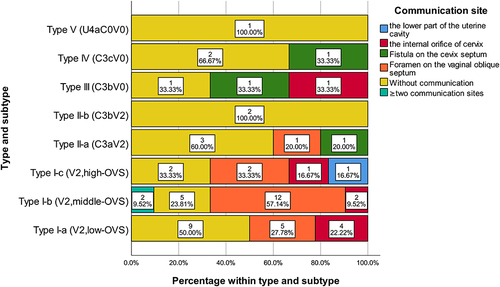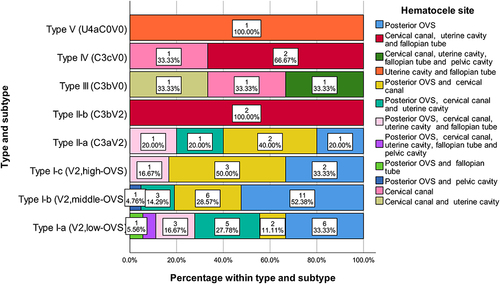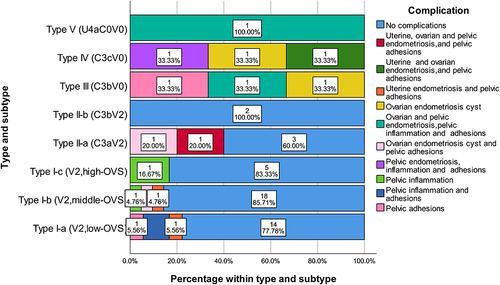Figures & data
Table 1 The Anatomical Combination of the Utero-Cervical-Vaginal Anatomy and the Site of Communication in Different Types of UGTOIRA Syndrome
Figure 1 Anatomical illustrations of the utero-cervical-vaginal anatomy in type I UGTOIRA syndrome (vaginal obstruction).Complete bicorporeal uterus, double cervix without cervical obstruction, and low oblique vaginal septum, without communication (A), with a foramen in the oblique vaginal septum (B), with a fistula connecting the oblique vaginal septum and the contralateral cervix (C); complete bicorporeal uterus, septate cervix without cervical obstruction, and low oblique vaginal septum, without communication (D), with a foramen in the oblique vaginal septum (E), with a fistula in the cervix septum (F); partial bicorporeal septate uterus, septate cervix without cervical obstruction, and low oblique vaginal septum, without communication (G), with a foramen in the oblique vaginal septum (H), with a fistula in the cervix septum (I), with communication between both internal orifices of the cervix (J); complete septate uterus, septate cervix without cervical obstruction, and low oblique vaginal septum, without communication (K), with a foramen in the oblique vaginal septum (L), with a fistula in the cervix septum (M), with communication between both internal orifices of the cervix (N).
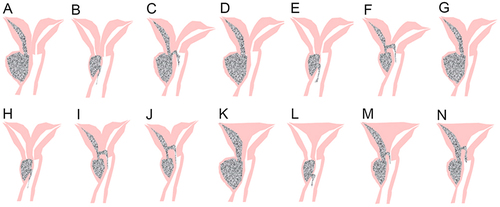
Figure 2 Anatomical illustrations of the utero-cervical-vaginal anatomy in Type II UGTOIRA syndrome (cervicovaginal obstruction).Partial bicorporeal uterus, septate cervix with unilateral cervical dysplasia, and high oblique vaginal septum, with the communication between the left and right lower portions of the uterine cavity (A); partial bicorporeal septate uterus, septate cervix with unilateral cervical dysplasia, and high oblique vaginal septum, without communication (B), with a fistula in the cervix septum (C), with communication between both internal orifices of the cervix (D); partial septate uterus, septate cervix with unilateral cervical dysplasia, and high oblique vaginal septum, with the communication between the left and right lower portions of the uterine cavity (E); complete septate uterus, septate cervix with unilateral cervical dysplasia, and high oblique vaginal septum, without communication (F), with a fistula in the cervix septum (G), with communication of both internal orifices of cervix (H);complete bicorporeal uterus, double cervix with unilateral obliterated cervical os, and high oblique vaginal septum, without communication (I); partial bicorporeal septate uterus, septate cervix with unilateral obliterated cervical os, and high OVS, without communication (J), with a fistula in the cervical septum (K), with communication of both internal orifices of cervix (L).
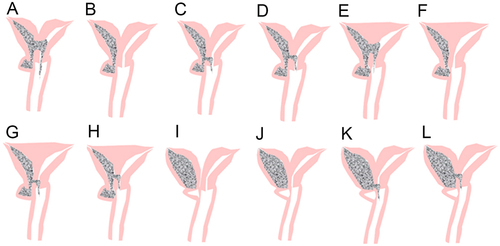
Figure 3 Anatomical illustrations of the utero-cervical-vaginal anatomy in Type III UGTOIRA syndrome (cervical obstruction).Partial bicorporeal septate uterus, septate cervix with unilateral obliterated cervical os, with one normal vagina, without communication (A), with a fistula in the cervical septum (B), with communication between both internal orifices of the cervix (C); complete septate uterus, septate cervix with ipsilateral obliterated cervical os, with one normal vagina, without communication (D), with a fistula in the cervical septum (E), with communication between both internal orifices of the cervix (F).

Figure 4 Anatomical illustrations of the utero-cervical-vaginal anatomy in Type IV UGTOIRA syndrome (unilateral partial cervical aplasia). Complete bicorporeal uterus, double cervix with unilateral partial cervical aplasia, with one normal vagina, without communication (A), with partial cervical fusion and a fistula in the cervical fusion (B).

Figure 5 Anatomical illustration of the utero-cervical-vaginal anatomy in Type V UGTOIRA syndrome (Unilateral isthmus atresia). Complete bicorporeal uterus with unilateral isthmus atresia, double cervix with completely undeveloped ipsilateral cervix which looks like a normal cervix, with one normal vagina, without communication.

Table 2 Baseline Characteristics (n=59)
Figure 6 The number and incidence of different complaints in different types and subtypes of UGTOIRA syndrome (n=59).
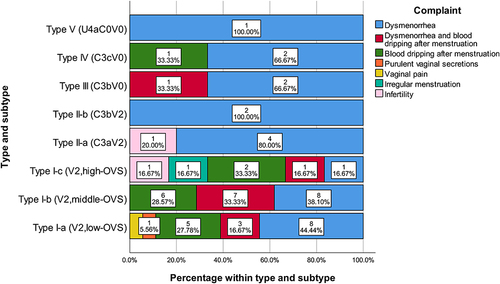
Figure 7 The number and incidence of different complaints in communication and non-communication groups (n=59).
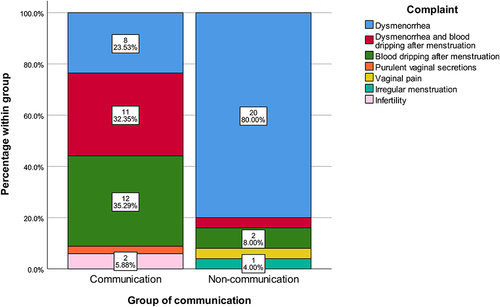
Table 3 The Numbers and Incidences of Different Types and Subtypes of UGTOIRA Syndrome (n=59)
Figure 8 The number and incidence of different communication sites in different types and subtypes of UGTOIRA syndrome (n=59).
